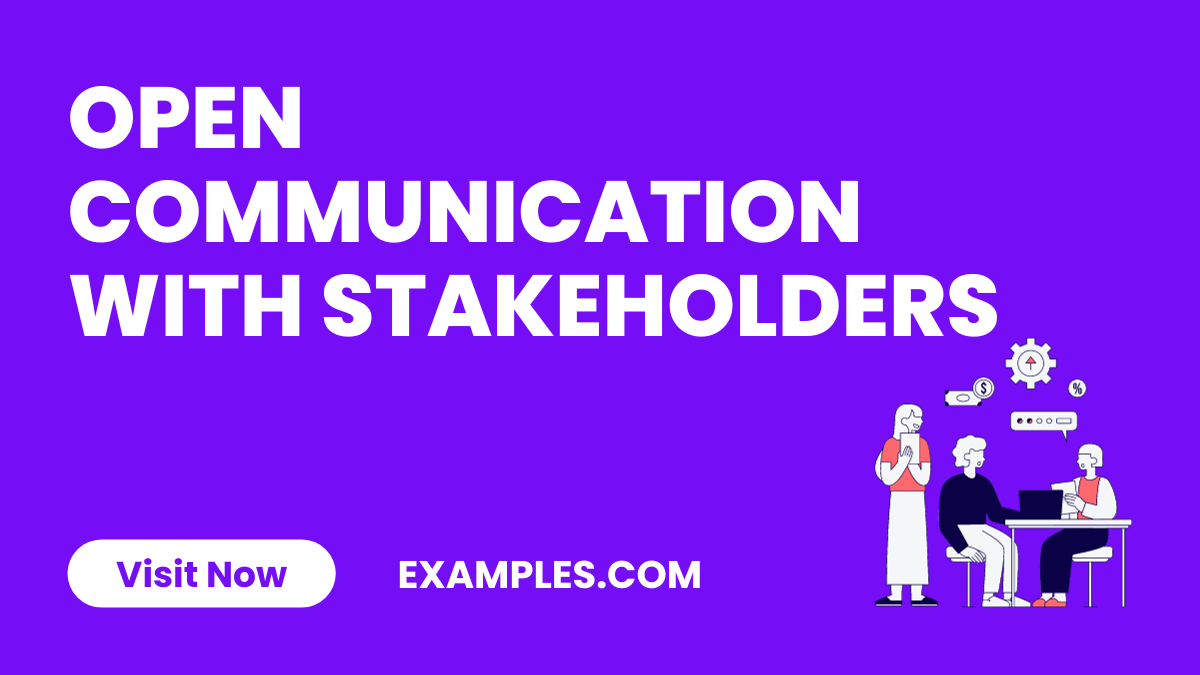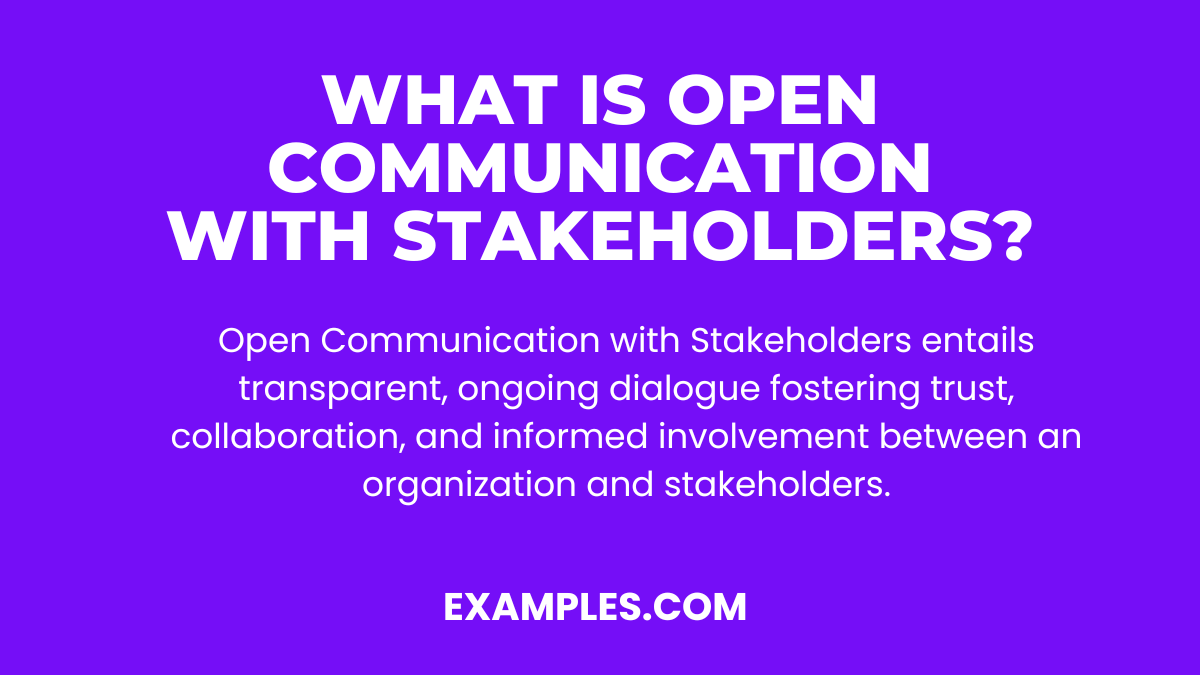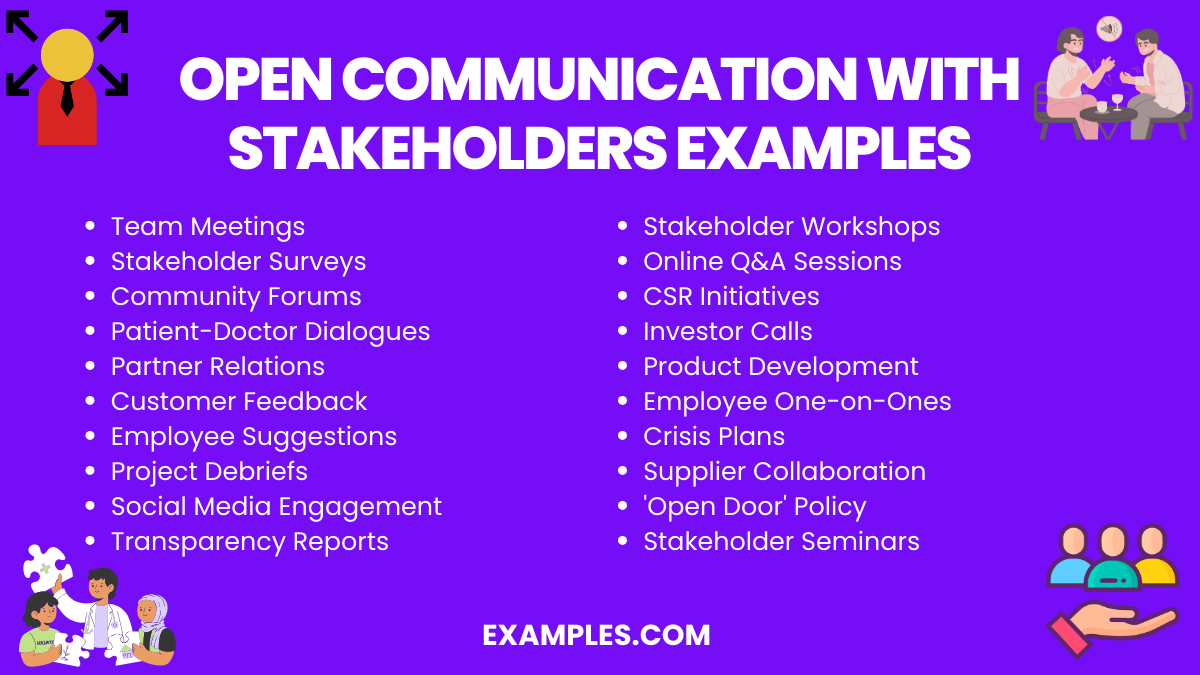20+ Open Communication with Stakeholders Examples
Delve into the comprehensive guide on Open Communication with Stakeholders, a vital strategy in today’s interconnected world. Discover various communication with stakeholders examples that illustrate successful dialogues and collaborative efforts. Learn how open communication fosters transparency, trust, and mutual growth. This guide provides insights into effective techniques and real-life Communication Examples, ensuring you have the tools to engage stakeholders effectively.
Download Importance of Open Communication with Stakeholders in Project Management PDF
What is Open Communication with Stakeholders? – Meaning
Open Communication with Stakeholders refers to the transparent and ongoing dialogue between an organization and its stakeholders. It encompasses a range of communication methods aimed at sharing information, addressing concerns, and fostering an environment of trust and collaboration. The essence of Open Communication is to ensure all parties are informed, involved, and invested in the outcomes, promoting a healthy, cooperative relationship.
What is the Best Example of Open Communication with Stakeholders?
One of the best examples of Open Communication with Stakeholders is the use of interactive platforms that facilitate real-time feedback and dialogue. This might include digital forums where stakeholders can voice concerns, contribute ideas, and receive direct responses from the organization. Such platforms demonstrate a commitment to transparency, responsiveness, and a genuine interest in stakeholder input, embodying the principles of open, two-way communication.
20 Open Communication with Stakeholders Examples
Open communication with stakeholders is pivotal in forging strong relationships and successful outcomes in various domains. Emphasizing the Importance of Open Communication, this article explores diverse scenarios, highlighting the benefits and how to address challenges effectively. From Open Communication in the Workplace to its role in healthcare, each example sheds light on the significance and practical methods of maintaining transparent dialogue.
- Regular Team Meetings: Encouraging Open Communication in the Workplace by holding frequent team meetings to discuss progress and challenges. This fosters a culture of honesty and collaboration.
- Stakeholder Surveys: Using surveys to gather feedback, demonstrating the Importance of Open Communication in understanding stakeholder perspectives.
- Community Forums: Facilitating community forums for stakeholders to voice opinions, highlighting Open Communication Benefits in community engagement.
- Patient-Doctor Dialogues: Emphasizing Open Communication in Healthcare through transparent patient-doctor conversations, enhancing patient care.
- Partner Relationship Management: Implementing open dialogue strategies in business partnerships, showing why open communication is important in the workplace.
- Customer Feedback Systems: Creating systems for customers to easily provide feedback, an example of honest communication in customer relations.
- Employee Suggestion Boxes: Encouraging employees to share ideas and concerns anonymously, fostering an atmosphere of Open Mind Communication.
- Project Debriefs: Conducting project debriefs with stakeholders to discuss successes and areas for improvement.
- Social Media Engagement: Actively engaging with stakeholders on social media platforms, reflecting How to Promote Open Communication.
- Transparency Reports: Publishing regular transparency reports to keep stakeholders informed about company operations and decisions.
- Stakeholder Workshops: Organizing workshops with stakeholders to collaboratively work on issues and solutions.
- Online Q&A Sessions: Hosting online Q&A sessions for real-time stakeholder interaction.
- Corporate Social Responsibility (CSR) Initiatives: Involving stakeholders in CSR activities, enhancing community relations.
- Investor Conference Calls: Conducting regular calls with investors to provide updates and receive feedback.
- Feedback-Based Product Development: Using stakeholder feedback in product development processes.
- Employee One-on-Ones: Regular one-on-one meetings with employees to discuss their experiences and ideas.
- Crisis Communication Plans: Having clear communication plans for crisis situations, ensuring stakeholders are promptly informed.
- Supplier Collaboration Sessions: Collaborating with suppliers to improve products and services.
- Leadership ‘Open Door’ Policy: Leaders maintaining an open-door policy for all stakeholders.
- Educational Seminars for Stakeholders: Hosting seminars to educate stakeholders on relevant topics and industry trends.
Open Communication with Stakeholders in a Project
Engaging stakeholders effectively within a project is critical for success, highlighting the open communication with manager and other key players. This section delves into the strategic implementation of open communication practices in project settings, emphasizing the open communication with colleagues and leadership. Discover five unique examples that bring forth the essence and application of Open Communication in Leadership to drive project success.
- Regular Progress Updates: Keeping stakeholders updated on project progress. “We will provide weekly updates every Monday to keep all stakeholders informed of our progress and any challenges encountered.”
- Stakeholder Inclusion Meetings: Involving stakeholders in key decision-making processes. “Let’s include our stakeholders in the next planning session to gather their insights and concerns.”
- Feedback Loops: Implementing structured feedback loops for continuous improvement. “After each project phase, we’ll solicit feedback from all stakeholders to identify areas for improvement.”
- Risk Communication Strategy: Sharing potential risks and mitigation plans with stakeholders. “We have identified potential risks in the upcoming phase and would like to discuss our mitigation strategies with you.”
- Clear Roles and Responsibilities: Clarifying everyone’s roles and expectations in the project. “During our kickoff meeting, we will clarify each stakeholder’s role and responsibility to ensure clear communication throughout the project.”
How Can You Establish Open Communication for Stakeholder Engagement?
Establishing open communication for stakeholder engagement is pivotal for ensuring project success and building lasting relationships. It’s about creating a foundation of trust and transparency.
- Identify and Understand Stakeholders: Begin by identifying all potential stakeholders. Understand their interests, needs, and preferred communication methods.
- Develop a Communication Plan: Tailor a comprehensive plan that outlines what will be communicated, when, how, and by whom.
- Implement Interactive Tools: Use tools that facilitate open communication with parents and other stakeholders, such as digital platforms for sharing information and receiving feedback.
- Regularly Update and Inform: Keep all stakeholders informed about project developments, changes, and decisions.
- Encourage Feedback and Participation: Create an environment where stakeholders feel comfortable sharing their opinions and know that their input is valued.
What is the Importance of Open Communication with Stakeholders?
Open communication with stakeholders is crucial as it leads to better decision-making, enhanced trust, and more successful outcomes.
- Builds Trust: Transparent communication builds a foundation of trust, crucial for any successful relationship.
- Ensures Alignment: Keeps everyone on the same page, reducing misunderstandings and aligning goals.
- Encourages Engagement: When stakeholders are informed and involved, they are more likely to be engaged and supportive.
- Improves Problem-Solving: With open communication with child and other stakeholders, problems can be identified and addressed more quickly and collaboratively.
- Enhances Reputation: Consistent and Honest Communication improves your organization’s reputation among stakeholders.
How Should You Have Open Communications And Maintain Them with Stakeholders?
Having and maintaining open communications with stakeholders is about consistent effort and strategic approaches to keep the dialogue alive and productive.
- Set Clear Communication Objectives: Define what you want to achieve with your communication efforts, ensuring alignment with overall project or organizational goals.
- Use Varied Communication Channels: Employ a mix of channels to reach different stakeholders effectively, acknowledging that some may prefer direct meetings while others might prefer digital correspondence.
- Regularly Review and Adapt: Continuously assess the effectiveness of your communication strategies and be willing to make necessary adjustments.
- Foster a Culture of Openness: Lead by example and create a culture where Open Communication in Family and other environments is encouraged and practiced.
- Build Long-term Relationships: Focus on building lasting relationships with stakeholders through open communication with patients, open communication with students, and other key groups.
What is the Benefit of Communicating Openly with Suppliers as Stakeholders?
Open communication with suppliers ensures transparency, builds trust, and facilitates smoother operations and negotiations, enhancing overall efficiency.
How to Establish and Maintain Open Communication with Stakeholders?
To establish and maintain open communication, create a detailed plan, use diverse channels, regularly review strategies, and ensure continuous engagement and feedback.
What is Best Practices Related to Open Communication with Stakeholders from Your Previous Projects?
Best practices include being consistent, transparent, and receptive. Understanding the differences in Open Communication vs Closed Communication and Open Communication vs Direct Communication is crucial.
In conclusion, open communication with stakeholders is pivotal in project management. Through real-world examples, we’ve seen its positive effects, such as increased trust and efficiency. Recognizing signs of Poor Communication is crucial for timely intervention. To fix Communication Gaps, prioritize transparency, actively engage stakeholders, and adapt your approach. By fostering a culture of open communication, projects can thrive and achieve their objectives effectively.
20+ Open Communication with Stakeholders Examples

Delve into the comprehensive guide on Open Communication with Stakeholders, a vital strategy in today’s interconnected world. Discover various communication with stakeholders examples that illustrate successful dialogues and collaborative efforts. Learn how open communication fosters transparency, trust, and mutual growth. This guide provides insights into effective techniques and real-life Communication Examples, ensuring you have the tools to engage stakeholders effectively.
Download Importance of Open Communication with Stakeholders in Project Management PDF
What is Open Communication with Stakeholders? – Meaning
Open Communication with Stakeholders refers to the transparent and ongoing dialogue between an organization and its stakeholders. It encompasses a range of communication methods aimed at sharing information, addressing concerns, and fostering an environment of trust and collaboration. The essence of Open Communication is to ensure all parties are informed, involved, and invested in the outcomes, promoting a healthy, cooperative relationship.
What is the Best Example of Open Communication with Stakeholders?
One of the best examples of Open Communication with Stakeholders is the use of interactive platforms that facilitate real-time feedback and dialogue. This might include digital forums where stakeholders can voice concerns, contribute ideas, and receive direct responses from the organization. Such platforms demonstrate a commitment to transparency, responsiveness, and a genuine interest in stakeholder input, embodying the principles of open, two-way communication.
20 Open Communication with Stakeholders Examples
Open communication with stakeholders is pivotal in forging strong relationships and successful outcomes in various domains. Emphasizing the Importance of Open Communication, this article explores diverse scenarios, highlighting the benefits and how to address challenges effectively. From Open Communication in the Workplace to its role in healthcare, each example sheds light on the significance and practical methods of maintaining transparent dialogue.
Regular Team Meetings: Encouraging Open Communication in the Workplace by holding frequent team meetings to discuss progress and challenges. This fosters a culture of honesty and collaboration.
Stakeholder Surveys: Using surveys to gather feedback, demonstrating the Importance of Open Communication in understanding stakeholder perspectives.
Community Forums: Facilitating community forums for stakeholders to voice opinions, highlighting Open Communication Benefits in community engagement.
Patient-Doctor Dialogues: Emphasizing Open Communication in Healthcare through transparent patient-doctor conversations, enhancing patient care.
Partner Relationship Management: Implementing open dialogue strategies in business partnerships, showing why open communication is important in the workplace.
Customer Feedback Systems: Creating systems for customers to easily provide feedback, an example of honest communication in customer relations.
Employee Suggestion Boxes: Encouraging employees to share ideas and concerns anonymously, fostering an atmosphere of Open Mind Communication.
Project Debriefs: Conducting project debriefs with stakeholders to discuss successes and areas for improvement.
Social Media Engagement: Actively engaging with stakeholders on social media platforms, reflecting How to Promote Open Communication.
Transparency Reports: Publishing regular transparency reports to keep stakeholders informed about company operations and decisions.
Stakeholder Workshops: Organizing workshops with stakeholders to collaboratively work on issues and solutions.
Online Q&A Sessions: Hosting online Q&A sessions for real-time stakeholder interaction.
Corporate Social Responsibility (CSR) Initiatives: Involving stakeholders in CSR activities, enhancing community relations.
Investor Conference Calls: Conducting regular calls with investors to provide updates and receive feedback.
Feedback-Based Product Development: Using stakeholder feedback in product development processes.
Employee One-on-Ones: Regular one-on-one meetings with employees to discuss their experiences and ideas.
Crisis Communication Plans: Having clear communication plans for crisis situations, ensuring stakeholders are promptly informed.
Supplier Collaboration Sessions: Collaborating with suppliers to improve products and services.
Leadership ‘Open Door’ Policy: Leaders maintaining an open-door policy for all stakeholders.
Educational Seminars for Stakeholders: Hosting seminars to educate stakeholders on relevant topics and industry trends.
Open Communication with Stakeholders in a Project
Engaging stakeholders effectively within a project is critical for success, highlighting the open communication with manager and other key players. This section delves into the strategic implementation of open communication practices in project settings, emphasizing the open communication with colleagues and leadership. Discover five unique examples that bring forth the essence and application of Open Communication in Leadership to drive project success.
Regular Progress Updates: Keeping stakeholders updated on project progress. “We will provide weekly updates every Monday to keep all stakeholders informed of our progress and any challenges encountered.”
Stakeholder Inclusion Meetings: Involving stakeholders in key decision-making processes. “Let’s include our stakeholders in the next planning session to gather their insights and concerns.”
Feedback Loops: Implementing structured feedback loops for continuous improvement. “After each project phase, we’ll solicit feedback from all stakeholders to identify areas for improvement.”
Risk Communication Strategy: Sharing potential risks and mitigation plans with stakeholders. “We have identified potential risks in the upcoming phase and would like to discuss our mitigation strategies with you.”
Clear Roles and Responsibilities: Clarifying everyone’s roles and expectations in the project. “During our kickoff meeting, we will clarify each stakeholder’s role and responsibility to ensure clear communication throughout the project.”
How Can You Establish Open Communication for Stakeholder Engagement?
Establishing open communication for stakeholder engagement is pivotal for ensuring project success and building lasting relationships. It’s about creating a foundation of trust and transparency.
Identify and Understand Stakeholders: Begin by identifying all potential stakeholders. Understand their interests, needs, and preferred communication methods.
Develop a Communication Plan: Tailor a comprehensive plan that outlines what will be communicated, when, how, and by whom.
Implement Interactive Tools: Use tools that facilitate open communication with parents and other stakeholders, such as digital platforms for sharing information and receiving feedback.
Regularly Update and Inform: Keep all stakeholders informed about project developments, changes, and decisions.
Encourage Feedback and Participation: Create an environment where stakeholders feel comfortable sharing their opinions and know that their input is valued.
What is the Importance of Open Communication with Stakeholders?
Open communication with stakeholders is crucial as it leads to better decision-making, enhanced trust, and more successful outcomes.
Builds Trust: Transparent communication builds a foundation of trust, crucial for any successful relationship.
Ensures Alignment: Keeps everyone on the same page, reducing misunderstandings and aligning goals.
Encourages Engagement: When stakeholders are informed and involved, they are more likely to be engaged and supportive.
Improves Problem-Solving: With open communication with child and other stakeholders, problems can be identified and addressed more quickly and collaboratively.
Enhances Reputation: Consistent and Honest Communication improves your organization’s reputation among stakeholders.
How Should You Have Open Communications And Maintain Them with Stakeholders?
Having and maintaining open communications with stakeholders is about consistent effort and strategic approaches to keep the dialogue alive and productive.
Set Clear Communication Objectives: Define what you want to achieve with your communication efforts, ensuring alignment with overall project or organizational goals.
Use Varied Communication Channels: Employ a mix of channels to reach different stakeholders effectively, acknowledging that some may prefer direct meetings while others might prefer digital correspondence.
Regularly Review and Adapt: Continuously assess the effectiveness of your communication strategies and be willing to make necessary adjustments.
Foster a Culture of Openness: Lead by example and create a culture where Open Communication in Family and other environments is encouraged and practiced.
Build Long-term Relationships: Focus on building lasting relationships with stakeholders through open communication with patients, open communication with students, and other key groups.
What is the Benefit of Communicating Openly with Suppliers as Stakeholders?
Open communication with suppliers ensures transparency, builds trust, and facilitates smoother operations and negotiations, enhancing overall efficiency.
How to Establish and Maintain Open Communication with Stakeholders?
To establish and maintain open communication, create a detailed plan, use diverse channels, regularly review strategies, and ensure continuous engagement and feedback.
What is Best Practices Related to Open Communication with Stakeholders from Your Previous Projects?
Best practices include being consistent, transparent, and receptive. Understanding the differences in Open Communication vs Closed Communication and Open Communication vs Direct Communication is crucial.
In conclusion, open communication with stakeholders is pivotal in project management. Through real-world examples, we’ve seen its positive effects, such as increased trust and efficiency. Recognizing signs of Poor Communication is crucial for timely intervention. To fix Communication Gaps, prioritize transparency, actively engage stakeholders, and adapt your approach. By fostering a culture of open communication, projects can thrive and achieve their objectives effectively.





